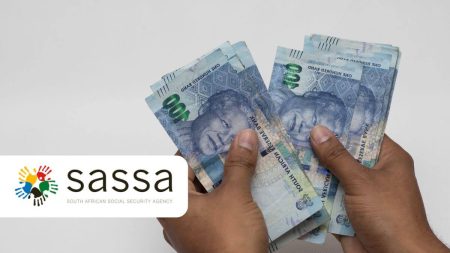Losing your SIM card can be a stressful experience, especially if it’s tied to essential services like your SASSA grant. The R370 SASSA grant is a lifeline for many South Africans, providing much-needed support to those who are unemployed or facing financial difficulties. If you’ve lost your SIM card and are concerned about how to access your SASSA grant, don’t worry.
This article will guide you through the steps to recover your grant and ensure you continue receiving the support you need.

What to Do If You’ve Lost Your SIM Card Linked to Your SASSA Grant
Losing your SIM card is a common issue, but it can be resolved quickly if you follow the right steps. Below, we outline a clear process to help you recover your SASSA grant after losing your SIM card.
1. Stay Calm and Assess the Situation
The first thing to do when you realize you’ve lost your SIM card is to stay calm. Losing a SIM card is a common issue, and there are several steps you can take to resolve the situation. Assess the situation and make sure that your SIM card is truly lost and not just misplaced. If you’re certain it’s lost, the next steps will help you recover your SASSA grant.
2. Report the Loss of Your SIM Card
As soon as you realize your SIM card is lost, report it to your mobile service provider. This is important to prevent unauthorized access to your accounts, including your SASSA grant. Most service providers have a customer service number you can call to report the loss. Alternatively, you can visit a local branch of your service provider to report the issue in person.
When reporting the loss, you’ll need to provide identification and other personal details to verify your identity. Once the loss is reported, your service provider will block the SIM card, preventing anyone else from using it.
3. Get a SIM Swap
After reporting the loss, the next step is to get a SIM swap. A SIM swap allows you to retain your phone number even after losing your SIM card. Here’s how to do it:
- Visit your mobile service provider: Go to the nearest branch of your mobile service provider. Take your ID document with you, as you’ll need it to complete the SIM swap.
- Request a SIM swap: Inform the customer service representative that you need a SIM swap. They will guide you through the process and provide you with a new SIM card.
- Activate your new SIM card: Once you have your new SIM card, it will need to be activated. This process usually takes a few hours but can sometimes take up to 24 hours. Once activated, you’ll have access to your old phone number again.
Related: How to Reapply for SASSA R370 Grant After Cancelling
4. Update Your Contact Information with SASSA
If you were unable to get a SIM swap and had to obtain a new phone number, it is essential to update your contact information with SASSA. This step is crucial to ensure that you continue receiving important notifications and your R370 SASSA grant payments without any disruptions.
To update your contact information with SASSA:
- Initiate the Process: Start by navigating to the SASSA SRD grant contact details page. Have your South African ID number and Application ID ready.
- Verification: After entering your ID number and Application ID, hit the “Submit” button. You’ll then be prompted to provide both your email address and the new cellphone number you wish to associate with your grant.
- Reason for Change: Choose a reason for changing your number. Options include “cellphone stolen or lost” and “used someone else’s mobile number to apply and now cannot get hold of that person.” It is crucial to select the option that accurately reflects your situation.
- One-Time Pin (OTP) Verification: Once you submit your new number, an OTP will be sent to it. Enter this OTP to confirm the change.
- Finalization: With the OTP verified, click “Submit” one last time. Your SASSA SRD Grant cellphone number is now updated.
5. Monitor Your SASSA Payments
Once you have updated your contact information with SASSA, it is crucial to monitor your grant payments. You should receive SMS notifications as usual, informing you of your payment dates and amounts.
6. Consider Using an Alternative R370 SASSA Grant Payment Method
If losing your SIM card has made you concerned about the security of your SASSA grant, you might want to consider using an alternative payment method. SASSA offers several payment options, including:
- Bank Account Payments: You can have your SASSA grant paid directly into your bank account. This option is secure and allows you to access your funds from any ATM or bank branch.
- Postbank Account: SASSA can pay your grant into a Postbank account, which you can access at any South African Post Office branch.
- CashSend Payments: Some mobile networks offer CashSend services, which allow you to receive your grant as a cash voucher that you can redeem at selected retailers.
If you are interested in changing your payment method, visit your nearest SASSA office and request the change. Make sure to bring your ID and any other required documents with you.
Read More: How Your Monthly SASSA Grant Payments Are Made
7. Keep Your SIM Card Safe
After recovering your SASSA grant, it’s essential to take steps to prevent losing your SIM card again. Here are a few tips to keep your SIM card safe:
- Store your phone securely: Always keep your phone in a safe place where it won’t easily get lost or stolen.
- Use a SIM card lock: Most phones allow you to set a SIM card lock, which requires a PIN to use the SIM card. This adds an extra layer of security.
- Keep a record of your SIM card number: Write down your SIM card number and store it in a safe place. This will make it easier to report and replace if it’s lost again.
Losing your SIM card can be a hassle, but with the right steps, you can recover your R370 SASSA grant and ensure you continue receiving your payments. By reporting the loss, completing a SIM swap, updating your contact information with SASSA, and monitoring your payments, you can resolve the issue quickly.
Remember to take precautions to keep your SIM card safe in the future to avoid similar problems.










